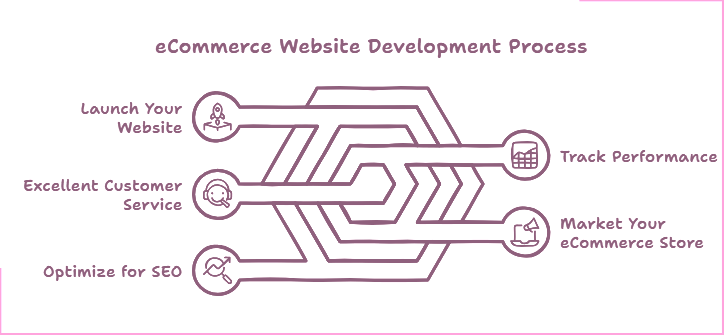As of 2024, there are 26.6 million eCommerce sites globally, which grew by 3.83% compared to the previous year. Approximately 2,685 new sites are launching daily.
This amazing growth is more than a number; the huge potential is waiting there for those interested in making it work for them. Still, in such a dynamic and competitive market like e-commerce, the fact that a product is fantastic is no longer enough. You need a good virtual shopfront to attract customers and convert clicks into sales for real success.
So, many people would like to run an ecommerce business but find that the realities of building an online store can feel overwhelming.This guide is your route to ecommerce success in 2025, complete with insights on the current trends, real-world examples, and new techniques.

What is eCommerce?
eCommerce refers to the online buying and selling goods and services by people and businesses anywhere, anytime. Transactions can be conducted on websites, online marketplaces, mobile apps, social media, and online stores.
eCommerce enterprises include subscription services, online merchants, digital marketplaces, freelancers, sole proprietors, and business-to-business (B2B) firms that provide services online.
What is an eCommerce Business?
An eCommerce business is an entity that buys and sells products or services through the internet. They operate through applications, websites, social media, or online marketplaces. eCommerce businesses may be small businesses owned by a single person or huge global corporations. They might use one website or multiple sales channels to get to their customers. Examples of businesses that make use of eCommerce include software companies, clothing brands, and subscription-based services.
e-business vs eCommerce
Although eCommerce and e-business are often used synonymously, they are two different aspects of online business. eCommerce refers to buying and selling various products and services online, including online retail sales, payment processing, and even digital goods transactions. eCommerce is more of a transactional business, where the deals are done between a customer and an online store ike Amazon to purchase. It is a sector where businesses derive most of their revenues through direct interaction with consumers.
Electronic business, however, refers to more comprehensive activities that involve applying digital technologies to enhance operations. It implies that it encompasses e-commerce transactions and processes like supply chain management, CRM, online marketing, and internal communications. E-business aims to promote efficiency and competitiveness by implementing digital tools across all levels of an organisation in B2B versus B2C contexts.
How to Build An eCommerce Website Step-by-Step Guide

Step 1: Define Your Business Model
Determine the type of eCommerce. You can sell products directly to customers (B2C), businesses (B2B), or through a marketplace. Identify profitable niches based on market trends and consumer needs, identify profitable niches.
Step 2: Plan & Reasearch
Market Consumers' expectations target market demand. Outline your business goals, strategies, and financial projections.
Step 3: Choose Domain Name and Hosting
Choose a domain name and choose a memorable and relevant document for your brand. Choose a reliable hosting service with good performance and security.
Step 4: Select an eCommerce Platform
Compare platforms based on your needs, and consider options like Odoo, Shopify, WooCommerce, Magento, or BigCommerce. Scale easily with your platform as your business grows.
Step 5: Design your Site
Select a template or theme, and choose a professional design related to your brand identity. Ensure it is easy to navigate, categorize products clearly, and use a user-friendly interface.
Step 6: Add Products
Create product listings, use high-quality, appealing descriptions, and use good-quality images for each product. Decide on pricing strategies and manage your inventory effectively.
Step 7: Implement Payment Gateways
Implement various payment gateways (using PayPal, Stripe, etc.).
Secure the site and provide an SSL certificate to ensure a secure transaction for customers.
Step 8: Shipping Options
Choose a shipping method to satisfy customer needs. You can select from several methods, such as standard or express. Calculate the rate according to weight, location, and speed of delivery.
Step 9: Optimize for SEO
Conduct keyword research and Identify relevant keywords in product descriptions and blog content. Optimize the pages for on-page SEO. Improve search engine visibility, use meta tags, alt text for images, and clean URLs.
Step 10: Launch Your Website
Check all functionalities and features, including payment processing, navigation, and mobile responsiveness. Go live and Announce your launch through social media, email marketing, and other channels.
Step 11: Market Your eCommerce Store
Use digital marketing strategies. Engage with customers through social media marketing. Utilize email marketing and Paid advertising to keep customers and sell to them.
Step 12: Track Performance
Track website traffic, conversion rates, and customer behaviour using tools like Google Analytics. AAnalysedata to refine marketing efforts and improve user experience.
Step 13: Excellent Customer Service
Set up customer support channels. Provide various avenues for customers to reach you (live chat, email, phone). Encourage reviews and feedback to improve products and services continuously.
Challenges of eCommerce Businesses
Creating an eCommerce website is not without its challenges. Here are some common obstacles businesses face:
Competition: It takes unique value propositions and effective marketing strategies to get noticed in a crowded marketplace.
Data Security: Undoubtedly customer information needs to be protected from breaches to ensure trust.
Customer Satisfaction: Consumers' expectations evolve concerning service, delivery, and product quality.
Shopping Cart Abandonment: Higher cart abandonment rates require easier checkout processes for customer retention.
Logistics Management: The shipping, returns, and inventory can be complex.
Read more in-depth :
Best SEO For Shopify: Complete Step By Step (2025)
SumUp
Building an eCommerce website is, and ensures, an exciting, promising venture with enormous opportunities for growth and success in 2025. Implement the processes described in this guide to define your business model clearly, optimize it for SEO, and ensure excellent customer service. You will certainly be on your way to setting up a robust online store that suits the needs of today's consumers.
Stay updated on industry changes, be receptive to emerging technologies, and listen to your customers; they will help you fine-tune your offerings. A successful approach will lead you to create an eCommerce website that drives sales and delivers long-term value to customers.